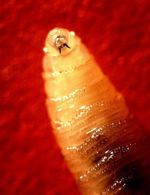Difference between revisions of "Chrysomya bezziana"
Jump to navigation
Jump to search
| Line 1: | Line 1: | ||
| − | + | {{unfinished}} | |
| + | |||
[[Image:Screw Worm.jpg|right|thumb|150px|Screw worm larvae - John Kucharski - Wikimedia Commons]] | [[Image:Screw Worm.jpg|right|thumb|150px|Screw worm larvae - John Kucharski - Wikimedia Commons]] | ||
| − | |||
| − | |||
| − | |||
| − | |||
| − | |||
| − | |||
| − | + | {| cellpadding="10" cellspacing="0" border="1" | |
| − | + | | Also known as: | |
| − | + | | '''Old world screwworm | |
| − | + | |- | |
| − | + | |} | |
| − | + | ===Scientific Classification=== | |
| − | + | {| cellpadding="10" cellspacing="0" border="1" | |
| − | + | | Class | |
| + | | Insecta | ||
| + | |- | ||
| + | | Order | ||
| + | | Diptera | ||
| + | |- | ||
| + | | Family | ||
| + | | Calliphoridae | ||
| + | |} | ||
| + | ==Hosts== | ||
| + | Cattle, sheep, dogs and occasionally humans. | ||
| − | ''' | + | ==Identification== |
| − | + | ''C. bezziana'' is a blue/green fly, with 4 longitudinal black stripes, and around 8-10mm in length. They are similar to [[Calliphoridae|''Calliphora spp.'']] | |
| − | + | ==Life Cycle== | |
| + | ''C. bezziana'' is an obligate agent of myiasis. The female lays eggs in fresh open wounds or body orifices. Eggs then hatch and the larvae begin to penetrate the skin. The larvae then mature and begin to pupate, before becoming fully reproductive adults. | ||
| − | + | The complete life cycle from egg to adult is 2-3 weeks. | |
| + | ==Clinical== | ||
'''Pathogenesis''' | '''Pathogenesis''' | ||
Revision as of 11:44, 22 July 2010
| This article is still under construction. |
| Also known as: | Old world screwworm |
Scientific Classification
| Class | Insecta |
| Order | Diptera |
| Family | Calliphoridae |
Hosts
Cattle, sheep, dogs and occasionally humans.
Identification
C. bezziana is a blue/green fly, with 4 longitudinal black stripes, and around 8-10mm in length. They are similar to Calliphora spp.
Life Cycle
C. bezziana is an obligate agent of myiasis. The female lays eggs in fresh open wounds or body orifices. Eggs then hatch and the larvae begin to penetrate the skin. The larvae then mature and begin to pupate, before becoming fully reproductive adults.
The complete life cycle from egg to adult is 2-3 weeks.
Clinical
Pathogenesis
- Spiracles are exposed as larvae feed which expands the wound
- Creates a foul smelling lesion
- Cause irritation and pyrexia
Control
- In the USA
- Mass eradication through the release of sterile males
- Currently only persists where flies have migrated across the Mexican border
- In Africa
- Introduced into Libya through the importation of infested livestock
- Sterile males released
- Eradication occurred in 1991
